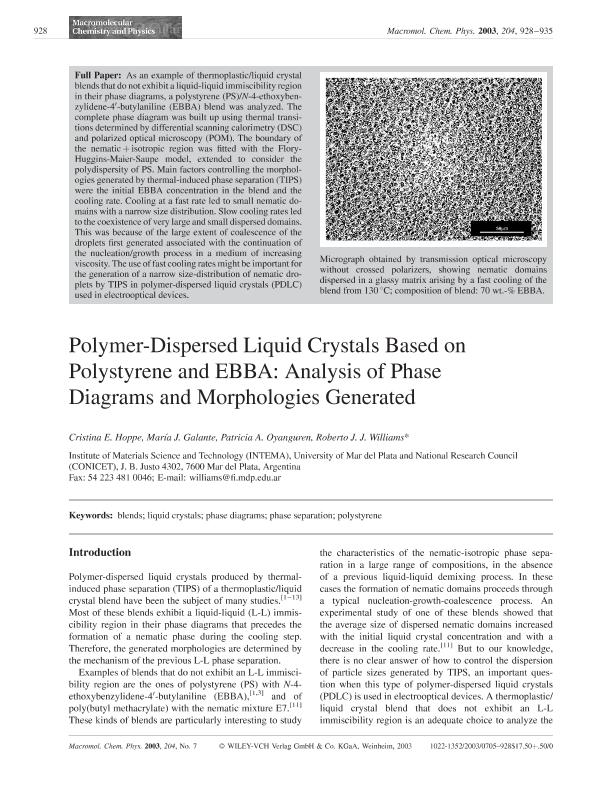Artículo
Polymer-dispersed liquid crystals based on polystyrene and EBBA: Analysis of phase diagrams and morphologies generated
Hoppe, Cristina Elena ; Galante, Maria Jose
; Galante, Maria Jose ; Oyanguren, Patricia Angelica
; Oyanguren, Patricia Angelica ; Williams, Roberto Juan Jose
; Williams, Roberto Juan Jose
 ; Galante, Maria Jose
; Galante, Maria Jose ; Oyanguren, Patricia Angelica
; Oyanguren, Patricia Angelica ; Williams, Roberto Juan Jose
; Williams, Roberto Juan Jose
Fecha de publicación:
29/05/2003
Editorial:
Wiley VCH Verlag
Revista:
Macromolecular Chemistry And Physics
ISSN:
1022-1352
Idioma:
Inglés
Tipo de recurso:
Artículo publicado
Clasificación temática:
Resumen
As an example of thermoplastic/liquid crystal blends that do not exhibit a liquid-liquid immiscibility region in their phase diagrams, a polystyrene (PS)/N-4-ethoxybenzylidene-4′-butylaniline (EBBA) blend was analyzed. The complete phase diagram was built up using thermal transitions determined by differential scanning calorimetry (DSC) and polarized optical microscopy (POM). The boundary of the nematic + isotropic region was fitted with the Flory-Huggins-Maier-Saupe model, extended to consider the polydispersity of PS. Main factors controlling the morphologies generated by thermal-induced phase separation (TIPS) were the initial EBBA concentration in the blend and the cooling rate. Cooling at a fast rate led to small nematic domains with a narrow size distribution. Slow cooling rates led to the coexistence of very large and small dispersed domains. This was because of the large extent of coalescence of the droplets first generated associated with the continuation of the nucleation/growth process in a medium of increasing viscosity. The use of fast cooling rates might be important for the generation of a narrow size-distribution of nematic droplets by TIPS in polymer-dispersed liquid crystals (PDLC) used in electrooptical devices.
Palabras clave:
Blends
,
Liquid Crystals
,
Phase Diagrams
,
Phase Separation
,
Polystyrene
Archivos asociados
Licencia
Identificadores
Colecciones
Articulos(INTEMA)
Articulos de INST.DE INV.EN CIENCIA Y TECNOL.MATERIALES (I)
Articulos de INST.DE INV.EN CIENCIA Y TECNOL.MATERIALES (I)
Citación
Hoppe, Cristina Elena; Galante, Maria Jose; Oyanguren, Patricia Angelica; Williams, Roberto Juan Jose; Polymer-dispersed liquid crystals based on polystyrene and EBBA: Analysis of phase diagrams and morphologies generated; Wiley VCH Verlag; Macromolecular Chemistry And Physics; 204; 7; 29-5-2003; 928-935
Compartir
Altmétricas



